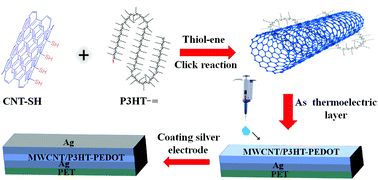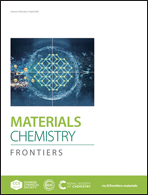Covalent interactions between carbon nanotubes and P3HT by thiol–ene click chemistry towards improved thermoelectric performance†
Abstract
A new covalent functionalization method is developed to produce a uniform multiwalled carbon nanotube/poly(3-hexylthiophene) (MWCNT–P3HT) nanocomposite via a thiol–ene click reaction between vinyl-terminated P3HT and thiol-functionalized MWCNTs. Microscopic and spectroscopic measurements confirm the covalent grafting of P3HT onto the surface of the MWCNTs. The covalently P3HT-functionalized MWCNTs show good dispersibility in hydrophobic solution. The intimate and permanent connection between the two components in the MWCNT–P3HT nanocomposite allowed the enhancement of charge transfer from P3HT to the MWCNTs. Relying on this unique feature, MWCNT–P3HT nanocomposite films for use in thermoelectric devices were fabricated, and the power generation characteristics were measured. Significantly, such MWCNT–P3HT nanocomposites showed more than twice the improved thermoelectric performance, as compared to directly mixed MWCNT/P3HT blends. This covalent grafting approach achieved via thiol–ene click chemistry offers a robust strategy for the synthesis of a variety of CNT-conductive polymer nanocomposites with an intimate contact interface for their potential application in energy conversion devices.



 Please wait while we load your content...
Please wait while we load your content...